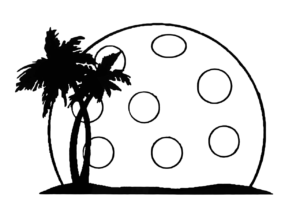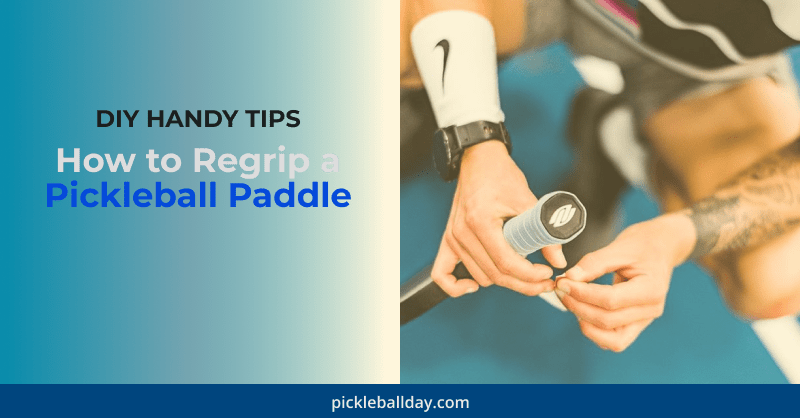You are on the right page if you are looking for how to replace a pickleball paddle grip. Most elements of pickleball are similar to those of tennis, ping pong, and badminton, and you are also aware that each sport has its special grip replacement techniques.
Replacing a pickleball paddle grip is not as complicated as it may seem, and it is a routine that every pickleball player should adopt. If you are still curious about how to go about it, don’t worry! Here you will get the most helpful pickleball grip technique. Furthermore, I will cover everything you need to know about correct paddle grip replacement.
Table of Contents
Why regripping your pickleball paddle is good
You can consider regripping or replacing grips and overgrips just as you take care of the other parts of the pickleball paddle. Here are the reasons why:
- You have used your pickleball paddle for a long time without regripping it.
- Your grip needs a new look.
- Do you like a thicker handle to adjust?
- You lost grip and accidentally flung the paddles while playing.
- You made a mistake in measuring the grip size, and now the grip’s circumference is a little smaller and must be adjusted to fit your natural grip.
- When you hit the ball, the paddle twists in your hand.
Be attentive to feeling the paddle grip in your hands. The reliability of the grip is what determines your game’s fate.
When to replace an old grip
Most pickleball players don’t understand that paddle grips are not replaced for losing gumminess. Pickleball paddles can last up to 2 to 3 years, whereas a grip will lose its stickiness much earlier. Grips have a low lifespan — approximately 100 to 150 hours of play is enough for the paddle grip to lose its tackiness. So you can only maintain the tackiness by regularly replacing the paddle grip.
Reasons why you should consider replacing your grip:
- You can’t feel the tackiness, only the silkiness.
- The grip twists when hitting the ball. This may also mean your grip does not fit your hands.
- The paddle accidentally flies across the pickleball court.
Replacing Grip for fun
If you are after the tackiness, it’s not worth replacing the entire grip. In addition to the reasons above, over-gripping also boosts tackiness. Besides, it increases the grip thickness and discourages replacing the whole grip.
Difference between tennis grip and pickleball grip
The length is the only significant difference between a tennis grip and a pickleball grip. Everything else, including the materials, is the same, except the size. Besides the longer length, a tennis racket has a larger diameter and wider grips.
What you need to regrip your paddle
Regripping pickleball paddle mainly needs an overgrip tape or replacement grip and probably a scissor. Some grips come with sticky tabs at the bottom and a short tape at the top.
You may encounter people using staple guns, screwdrivers, scissors, or a pair of pliers. Manufacturers add staples and may need extra tools to get rid of them before regripping.
Pickleball grip tape is the only necessary tool for regripping your paddle. Other tools are optional, except for a scissor, which is essential to remove existing grip tape.
How to regrip a pickleball paddle
Human is to error, they say. That’s why you may need two regrips in case you mess up. The design and making of a pickleball paddle are simple, and regripping is effortless. Let’s scroll down for ways to regrip your paddle.
Arrange your working space
Do not take this as a priority, but organizing your working equipment before starting it is good. Check out if you have:
- The grip (2 recommended)
- Sharp scissors
Besides the tools, have some patience too. Why patience? Regripping isn’t a one-time successful process. But don’t worry; these ways of regripping your paddle will get you through.
Concerning the pickleball paddle grip tape, you may go with any brand. Unwrap the tape band to remain with only the tape on the table.
Get rid of the existing grip
It’s time to remove the old skin! Remove the electrical tape at the top until you reach the handle’s bottom. Note that the paddle will look and feel sticky, and that’s normal. The sticky residue is not necessary to clean. However, if it has taken dust, the new grip tape might not stick properly. Just clean the handle with cleaning liquid and get it dry.
Confirm the grip tape
Start by checking the grip tape. Has it tampered with one side? Whatever brand you are using, yes should be the answer. Ensure the brand’s name is on the upper side to prevent upside-down regripping.
- Place the tapered end at the bottom of the paddle.
- Stick the tape firmly at the bottom. To achieve that, make sure you position it successfully.
- Don’t apply lightly; instead, pull tightly for every round. That will help if you are using a thick grip.
Gripping and cutting
- Grip your handle diagonally rather than horizontally.
- After gripping, excess grips need to be cut off from bottom to top.
- Congrats! You just made yourself a fully regripped pickleball paddle.
Difference between regrip and overgrip
A replacement grip entails replacing the stock grip that causes you sweatiness, loss of ball control, and loss of technique. On the other hand, over-gripping increases tackiness and absorption.
FAQs
Q1: Can you use a tennis overgrip on the pickleball paddle?
A: Yes. But tennis racquets are longer; therefore, you should be prepared to trim your work.
Q2: How long does an overgrip last?
A: A pickleball paddle overgrip may last 100 to 150 hours, depending on the player. If it’s a new one, it should go for longer.
Final wraps
Why not regrip your pickleball paddle today since you know how to replace a pickleball paddle grip? There are many benefits to that, including improvement in your playing techniques.


